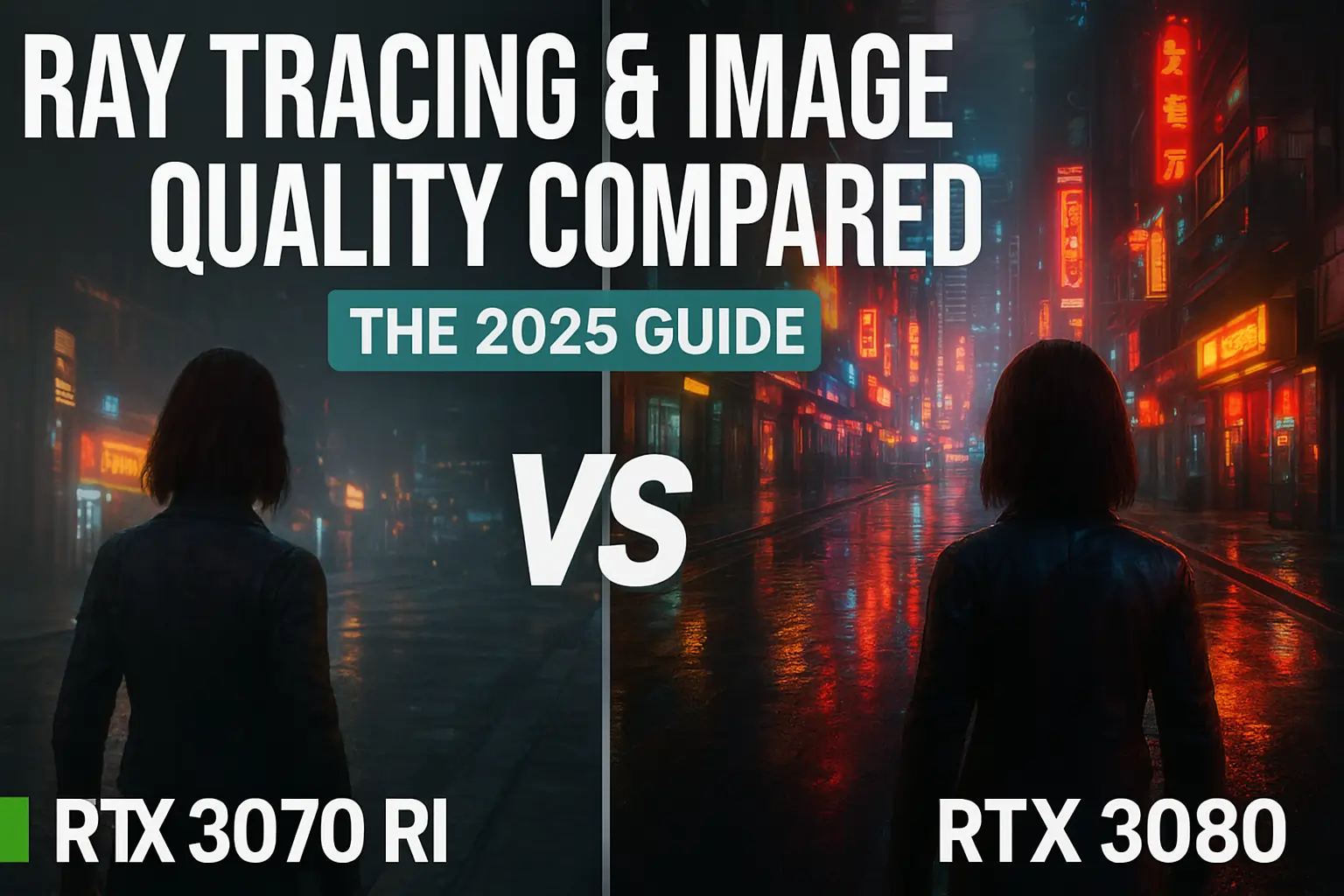If you’re building a new gaming rig or upgrading your PC, two GPUs from NVIDIA’s Ampere lineup keep popping up: the RTX 3080 and RTX 3070. Both support ray tracing and DLSS, but when it comes to RI (Ray tracing + Image quality), one clearly takes the crown.
So, is the RTX 3080 worth the extra money, or does the RTX 3070 give you better value in 2025?
Key Specs: RTX 3080 vs RTX 3070
| Feature | RTX 3080 | RTX 3070 |
|---|---|---|
| CUDA Cores | 8,704 | 5,888 |
| VRAM | 10GB GDDR6X | 8GB GDDR6 |
| Memory Bus | 320-bit | 256-bit |
| Bandwidth | 760 GB/s | 448 GB/s |
| TDP | 320W | 220W |
Takeaway: On paper, the RTX 3080 has more CUDA cores, faster memory, and higher bandwidth—three things that directly impact ray tracing and rendering performance.
Ray Tracing Performance: Who Wins?
Ray tracing is GPU-intensive, and not all cards handle it equally.
- RTX 3080: Built for 4K ray-traced gaming, this GPU can run Cyberpunk 2077, Control, and Metro Exodus at ultra settings with DLSS enabled, keeping smooth FPS. Its extra VRAM and bandwidth make lighting, shadows, and reflections seamless.
- RTX 3070: Solid for 1440p ray-traced gaming. You can still play the same titles, but you’ll need to tone down settings or rely more on DLSS. At 4K, performance dips sharply.
Winner: RTX 3080. If ray tracing is your priority, this card gives you a smoother and more future-proof experience.
Image Quality: Subtle but Noticeable Differences
Both GPUs support DLSS, NVIDIA Reflex, G-Sync, and Broadcast. But here’s where they differ:
- RTX 3080: Its faster GDDR6X VRAM processes high-res textures more efficiently. That means sharper images, smoother performance at 4K, and better handling of ultra settings.
- RTX 3070: Excellent for 1080p and 1440p, but in 4K workflows (gaming or creative), textures and frame buffers start hitting limits.
If you’re gaming on a 4K monitor or working in Adobe Premiere Pro/Blender, the RTX 3080 will look and feel better.
Power & Cooling: Can Your Build Handle It?
- RTX 3080: Needs 750W PSU minimum. Runs hotter, so a case with strong airflow is essential.
- RTX 3070: More power-efficient with 220W TDP. Works fine with a 650W PSU, easier for mid-range builds.
If you’re in India where electricity bills and cooling setups matter more, the RTX 3070 is cost-friendly. For US users aiming for max performance, the 3080 justifies its higher draw.
Price-to-Performance: Value vs Power
- RTX 3070: Incredible value card. Matches older RTX 2080 Ti performance at a lower cost. Perfect for budget-conscious gamers.
- RTX 3080: Costs more but delivers 20–30% higher performance in ray tracing and 4K gaming. Worth it for enthusiasts and professionals.
If your budget allows, the RTX 3080’s future-proofing pays off. Otherwise, the RTX 3070 is the sweet spot for 1440p gaming.
Who Should Buy Which GPU?
Buy RTX 3080 If You:
- Play games at 4K ultra with ray tracing.
- Work in 3D rendering, Unreal Engine, or Adobe Suite.
- Want maximum future-proofing for 3–4 years.
Buy RTX 3070 If You:
- Focus on 1440p gaming with occasional 4K.
- Have a mid-tier build (i5/Ryzen 5, 650W PSU).
- Are budget-conscious but still want ray tracing.
Final Verdict: RTX 3080 vs RTX 3070 RI
Both GPUs are excellent—but for different users.
- RTX 3080: The ray tracing and image quality king for 4K gamers and creators.
- RTX 3070: The value hero for 1440p users who want great visuals without overspending.
In short:
- USA Enthusiasts → Go RTX 3080.
- India Value Buyers → RTX 3070 is enough.
FAQs: RTX 3080 vs RTX 3070 RI
Q1: Is RTX 3080 worth it over RTX 3070 for gaming?
Yes—especially at 4K with ray tracing and DLSS.
Q2: Can RTX 3070 handle ray tracing?
Yes, but it’s best suited for 1080p/1440p gaming.
Q3: Which GPU is better for creators?
RTX 3080, thanks to more VRAM and higher bandwidth.
Q4: What PSU do I need for RTX 3080?
At least a 750W PSU from a reputed brand.
Q5: Are these GPUs still good in 2025?
Yes—both remain strong, though newer cards are available.

